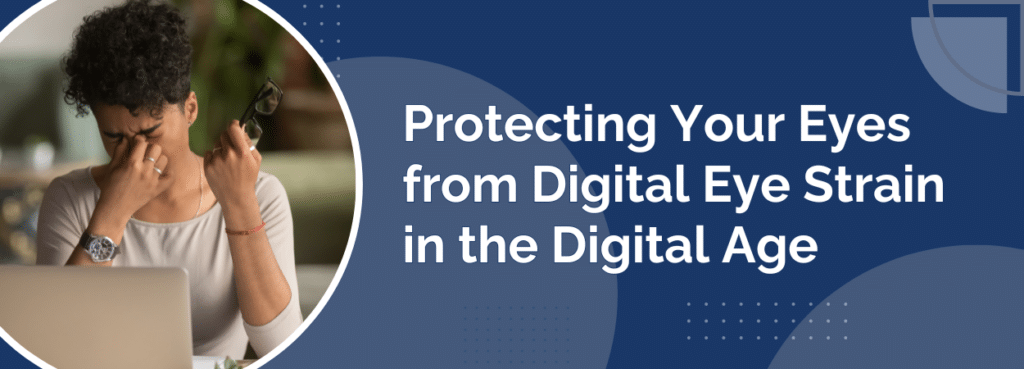Comprehensive Eye,Uncategorized

In an era dominated by digital screens, our eyes are constantly exposed to the demands of computers, smartphones, and other electronic devices. Dr. John F. Haarde, an expert optometrist at Sweeney Eye Associates, understands the impact of prolonged screen time on eye health. Read on to learn as we discuss Computer Vision Syndrome (CVS) and ways to safeguard your vision in the digital age.
Understanding Computer Vision Syndrome (CVS):
Computer Vision Syndrome, also known as Digital Eye Strain, is a common condition resulting from prolonged use of digital devices. Symptoms may include eyestrain, headaches, blurred vision, and dry eyes. Dr. John F. Haarde emphasizes the importance of recognizing and addressing CVS to maintain optimal eye health in the face of our digital lifestyles.
Problems Associated with Computer Vision Syndrome:
If computer vision syndrome (CVS) or digital eye strain is not adequately addressed, several potential issues can arise, impacting both short-term and long-term eye health. Some of the consequences include:
- Eye Discomfort: Prolonged exposure to digital screens without breaks can lead to symptoms such as eye strain, dry eyes, irritation, redness, and blurred vision.
- Headaches: CVS can cause headaches, especially if you are staring at screens for extended periods without proper ergonomics or breaks.
- Neck and Shoulder Pain: Poor posture while using digital devices can lead to neck and shoulder strain, contributing to discomfort and musculoskeletal issues.
- Sleep Disturbances: Blue light emitted from screens can interfere with your sleep patterns, making it harder to fall asleep or stay asleep, particularly if you use digital devices close to bedtime.
- Reduced Productivity: Eye discomfort and physical discomfort from CVS can affect your ability to concentrate and work efficiently, impacting productivity.
- Long-term Vision Problems: While CVS itself may not cause permanent eye damage, chronic exposure to digital screens without proper precautions could contribute to the development of long-term vision problems such as myopia (nearsightedness) or exacerbate existing refractive errors.
Combat Computer Vision Syndrome:
The 20/20/20 Rule:
One effective strategy to alleviate the effects of CVS is the 20/20/20 rule. This simple yet impactful guideline recommends taking a break every 20 minutes, looking at an object 20 feet away for at least 20 seconds. This brief pause allows your eyes to reset, reducing strain and preventing long-term discomfort associated with prolonged screen exposure.
Implementing the 20/20/20 Rule:
- Set Reminders: Use alarms or reminders on your devices to prompt you to take breaks at regular intervals.
- Follow the Rule Consistently: Make a conscious effort to adhere to the 20/20/20 rule consistently, especially during extended screen sessions.
- Adjust Screen Settings: Ensure that your device’s screen brightness, contrast, and font size are optimized for comfortable viewing.
- Proper Ergonomics: Position your screen at eye level and maintain a comfortable distance to reduce strain on your eyes, neck, and shoulders.
Some Tips for Digital Eye Wellness:
- Get Regular Eye Exams: Schedule routine eye examinations to detect and address any underlying vision issues promptly.
- Consider Blue Light Protection: Consider eyeglasses with blue light filtering coatings to minimize the potential harmful effects of prolonged exposure to digital screens.
- Blink Regularly: Remind yourself to blink regularly to prevent dry eyes, especially during focused screen time.
- Adjust Workspace Lighting: Ensure proper lighting in your workspace to reduce glare and minimize eye strain.
It is important to focus on the well-being of our eyes as we go about our daily activities in this digital age. For personalized advice and eye care, schedule a consultation with Dr. Haarde at Sweeney Eye Associates. Call us today at (972) 285-8966 or schedule an eye exam to prioritize your digital eye health.

